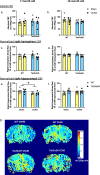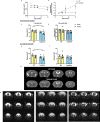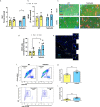Age-dependent cognitive impairment, hydrocephalus and leukocyte infiltration in transgenic mice with endothelial expression of human EPHX2
- PMID: 35927273
- PMCID: PMC9256583
- DOI: 10.1038/s41514-022-00090-1
Age-dependent cognitive impairment, hydrocephalus and leukocyte infiltration in transgenic mice with endothelial expression of human EPHX2
Abstract
Soluble epoxide hydrolase (sEH) is upregulated in microvascular endothelium of human brain with vascular cognitive impairment (VCI). Transgenic endothelial expression of human sEH in mice (Tie2hsEH) induces endothelial dysfunction (ED), a pathogenetic mechanism of VCI. We sought to determine if endothelial upregulation of sEH is sufficient to cause cognitive impairment, and if cognitive impairment due to chronic hypoperfusion induced by unilateral common carotid artery occlusion (CCAO) is exacerbated in Tie2hsEH mice. Behavioral performance was assessed by the open field, rotarod, novel object, Morris water maze and fear conditioning tests. Cerebral blood flow and brain morphology were evaluated by MRI, and inflammatory changes investigated using immunohistochemistry and flow cytometry. We demonstrate that transgenic endothelial expression of sEH is sufficient to induce cognitive impairment, associated with leukocyte infiltration, brain atrophy and accelerated, age-dependent ventriculomegaly, identifying ED and sEH upregulation as potential underlying mechanisms and therapeutic targets for VCI.
© 2022. The Author(s).
Conflict of interest statement
Financial competing interests are as follows: N.J.A. is co-inventor of technologies related to sEH and EETs signaling that have been licensed by OHSU and JHU to Precision Molecular and Vasocardea. This potential conflict of interest has been reviewed and managed by OHSU. All other authors declare no competing interests.
Figures





Similar articles
-
Neurobehavioral and imaging correlates of hippocampal atrophy in a mouse model of vascular cognitive impairment.Transl Stroke Res. 2015 Oct;6(5):390-8. doi: 10.1007/s12975-015-0412-z. Epub 2015 Jun 5. Transl Stroke Res. 2015. PMID: 26040424 Free PMC article.
-
Role of soluble epoxide hydrolase in age-related vascular cognitive decline.Prostaglandins Other Lipid Mediat. 2014 Oct;113-115:30-7. doi: 10.1016/j.prostaglandins.2014.09.003. Epub 2014 Sep 30. Prostaglandins Other Lipid Mediat. 2014. PMID: 25277097 Free PMC article.
-
High fat diet-induced diabetes in mice exacerbates cognitive deficit due to chronic hypoperfusion.J Cereb Blood Flow Metab. 2016 Jul;36(7):1257-70. doi: 10.1177/0271678X15616400. Epub 2015 Nov 11. J Cereb Blood Flow Metab. 2016. PMID: 26661233 Free PMC article.
-
Animal Models of Chronic Cerebral Hypoperfusion: From Mouse to Primate.Int J Mol Sci. 2019 Dec 7;20(24):6176. doi: 10.3390/ijms20246176. Int J Mol Sci. 2019. PMID: 31817864 Free PMC article. Review.
-
A brief overview of a mouse model of cerebral hypoperfusion by bilateral carotid artery stenosis.J Cereb Blood Flow Metab. 2023 Nov;43(2_suppl):18-36. doi: 10.1177/0271678X231154597. Epub 2023 Mar 8. J Cereb Blood Flow Metab. 2023. PMID: 36883344 Free PMC article. Review.
Cited by
-
Inhibition of soluble epoxide hydrolase confers neuroprotection and restores microglial homeostasis in a tauopathy mouse model.Mol Neurodegener. 2025 Apr 23;20(1):44. doi: 10.1186/s13024-025-00844-x. Mol Neurodegener. 2025. PMID: 40264187 Free PMC article.
-
Inhibition of Soluble Epoxide Hydrolase Confers Neuroprotection and Restores Microglial Homeostasis in a Tauopathy Mouse Model.Res Sq [Preprint]. 2025 Feb 24:rs.3.rs-6038641. doi: 10.21203/rs.3.rs-6038641/v1. Res Sq. 2025. Update in: Mol Neurodegener. 2025 Apr 23;20(1):44. doi: 10.1186/s13024-025-00844-x. PMID: 40060041 Free PMC article. Updated. Preprint.
-
Blood-Brain Barrier: A Shield Against Cognitive Decline.Stroke. 2024 Dec;55(12):2906-2908. doi: 10.1161/STROKEAHA.124.044227. Epub 2024 Jun 12. Stroke. 2024. PMID: 38864221 Free PMC article. No abstract available.
-
Soluble epoxide hydrolase inhibition reverses cognitive dysfunction in a mouse model of metabolic syndrome by modulating inflammation.Prostaglandins Other Lipid Mediat. 2024 Aug;173:106850. doi: 10.1016/j.prostaglandins.2024.106850. Epub 2024 May 10. Prostaglandins Other Lipid Mediat. 2024. PMID: 38735559 Free PMC article.
-
Insights on pathophysiology of hydrocephalus rats induced by kaolin injection.FASEB Bioadv. 2024 Aug 1;6(9):351-364. doi: 10.1096/fba.2024-00070. eCollection 2024 Sep. FASEB Bioadv. 2024. PMID: 39399473 Free PMC article.
References
Grants and funding
LinkOut - more resources
Full Text Sources

